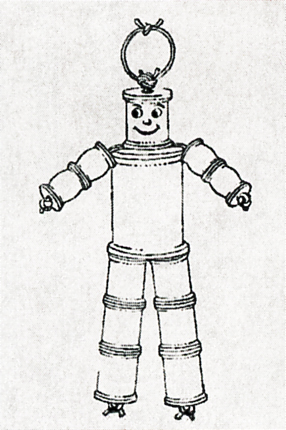When manufacturing in the United States went from peacetime to wartime production during World War II, materials like rubber, steel, and plastic became scarce or impossible to find for everyday use. Manufacturers stopped making most or all of their civilian products and switched to producing war materials. Toy companies took a major hit. And while some companies manufactured a few toys, only wealthy families could afford to buy them.
The toy shortage created a major problem for children because playing with toys is an important way for them to develop skills while growing up. Those skills include analyzing and solving problems, learning to get along with others, using their imagination, figuring out how things work, and becoming creative by developing new ideas. The U.S. Government was so concerned about this threat to childhood development that the Children’s Bureau of the U.S. Department of Labor published the pamphlet Toys in Wartime: Suggestions to Parents on Making Toys in Wartime.
Toys in Wartime explains how parents can make toys for children of all ages – from babies to adolescents – from common objects found around the home. By today’s standards, many of these toys would be considered very basic. Yet by using these “roughhewn” toys, kids could have fun and develop in a normal, healthy way while their families would save vital materials for the war effort.
The following entries and images sampled from the pamphlet are just a few of the recommended toys parents and kids could make for playtime:*
*Quotations have been copied directly from the pamphlet, Other text has been lightly edited for clarity and brevity.
Toys for Feeling, Chewing, Seeing, Listening
“The child from 8 or 9 months to 1 ½ to 2 years wants what will give him as many new sensations as possible.”
Doll Made from Spools
Kids can use spools for making a doll. Use small spools for the doll’s head, arms, and legs and a larger spool for the doll’s chest. Use strings to keep all the spools together, knotting them at the legs and hands, and tying all the strings together at the top of the head. The knots holding the arms and legs in place are the doll’s hands and feet. If they want, they can paint eyes, nose, and mouth on the doll too.
Things to Pull
“As soon as a young child becomes accustomed to walking and is able to do it without too much falling he likes to pull things around after him. Almost anything with a string attached will be pulled by the child. A dragged toy gets very much wear and should be sturdy.”

A pull toy put together with spools and scrap wood
Pull Toy Made from Spools
Use same-size spools, preferably large ones. Cut two pieces of wood twelve or fifteen inches long with a width less than the diameter of the spools. Attach crosspieces to the back and front. Place the spools inside the two lengths of wood but not touching one another. For each spool, drive a nail through one length of wood and through the spool hole and then through the other length of wood. The nails will be the axles to hold the “wheels” in place. Now attach a string to one crosspiece and start pulling.
Toys for War Play
“Children playing at war will want soldiers – perhaps to put in the tanks and planes they have built – and guns for the soldiers to carry.”
Toy Soldiers
Each child needs many toy soldiers – at least six to twelve – to play with. The easiest way to make a toy soldier is to take a block of wood that will stand by itself and either paste or paint a picture of a soldier on it. Or you can make a wedged-shaped block that will stand upright. Simply draw the outline of a soldier or some other figure on it, paint the figure, and then cut out the figure with a jigsaw. If you want, you can paint both front and back views on the block.

Toy soldier made from a cutout pasted to a wooden block
Drawing, Painting, Writing
“Almost all children love to paint and draw and many children are able to express themselves and their feelings in this way, who find it very difficult to do so in in language. Children are likely to be “messy” with paint and it would be well for a grown-up to be near when they are using it. Children should be encouraged to keep scrapbooks of their creative activities, such as drawing, painting, writing, and music.”
Easel
You can make an easel for drawing or painting from an old orange crate or box. On the back of the box, nail a piece of wood about 1 x 2 x 24 inches and another small piece of wood on the top of the orange crate. Take a piece of wallboard, heavy cardboard, or lightweight soft wood about 2 x 3 feet, lay it over the upright, and let it rest on the support in front. The center of the board should be opposite the child’s chest. You can fasten the paper to the board with thumbtacks or pins. If the orange crate or box has a partition, the child can use it as a shelf for storing supplies.

Painting easel made by repurposing an orange crate
Cutting and Pasting
“As soon as a child is able to manage a pair of blunt-ended scissors he is able to enjoy cutting. At first he “just cuts”; the thing made is of little importance. But from the time he is 3 or 4 until he is through school he might like to make things with paper or paste cuttings in a scrap book.”
“For paste, stir a few teaspoons full of ordinary flour with enough water to make a thin mixture and cook the mixture over a double boiler until it thickens. This paste should be made up fresh each time it is needed.”
Paper Chains
Cut narrow lengths of paper. Colored paper is best but you also can use colored pages from old magazines or even newspaper. Make the first length into a ring and fasten the ends together with paste. Slip the next length of paper through the ring and fasten its ends together with paste. Repeat the process until all the lengths of paper are used up and the chain is complete. “The chain is the chief joy, but the chains can be used to decorate the Christmas tree or the child’s bedroom.”
Weaving and Braiding
“A loom can be made at home. Its size depends upon the material to be woven and the purpose to which the finished product will be put. Small looms are on the whole more satisfactory for children than large ones because finishing a small piece of weaving gives the child a pleasant feeling of accomplishment.”
Looms
If you need to weave a fairly heavy material, a loom about 10 inches by 15 inches is satisfactory. If you have a wooden box about this size hanging around, you can use it to make a loom. If not, nail four pieces of wood together to make a frame. Partly hammer nails into two opposite ends of the box or frame, leaving enough of the nails protruding to tie strips for the warp. Your child can weave long strips of cloth or yarn through the warp. The child can whittle out a smooth piece of wood to use as the bobbin.
Dolls and Doll Houses
“Both boys and girls like to play with dolls during the preschool years. A corner of the playroom may be set aside for dolls and doll furniture. Most girls continue their interest in dolls up to their teens and the older boys may enjoy helping by building doll houses and making furniture.”
Doll Houses
Children eight years or older enjoy making and furnishing doll houses. Sometimes they need help building the doll house but it is better to let them do as much of the work as they can. You can use an orange crate for a doll house. Be sure to smooth down any rough wood with sandpaper. If the crate stands on end, the partition can be the second floor. For windows, you can cut holes in the side of the crate with a key-hole saw. You can leave the “windows” open or cover them with oiled paper or cellophane.
Some girls really enjoy designing and decorating the inside of a doll house. Their decorations can range from simple to elaborate. They can use scraps of old cloth for curtains, drapes, rugs, and furniture covering. Sometimes they can get a sample book of wallpaper. If the child wants color, she can use a yard of white cloth colored with vegetable dyes. For inspiration for colors and arrangements, she can look at pictures in magazines.
Boys are often as interested in designing the outside of the doll house as girls. They can paint the doll house a solid color or have a contrasting color for trim. If the child is really ambitious, she can paint bricks on the house. Small pieces of wood next to the windows can make shutters. Two boards can make a roof. A little clay can make a chimney. Gutters and leaders can be made from straws. And small boxes can be rain barrels.

A basic doll house also made from a repurposed orange crate
Natural Objects
Walnut shells make boats that bob around in a pool. A toothpick fastened with wax from a candle and stuck through a piece of paper in two places, makes the shell into a sailboat

Miniature sailboat made from a walnut shell




